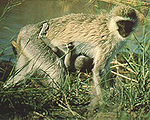Other Monkeys We Saw
Click here for the Black and White Colobus.
Click here for the Blue Monkey.
Click here for the Red-Tailed Monkey.
VERVET MONKEY

How to Recognize
Vervet monkeys are the most common monkeys to see. They are small and slender with a long tail, grizzled greenish-olive or silvery-gray
fur, a black face fringed with white, black hands, and a bluish belly skin that shows through their white belly fur. The male has a distinctive bright blue or turquoise scrotum and scarlet penis, an important signal of status in the troop.
Habitat
Vervet monkeys can be found on the ground or in trees (miombo and yellow acacias) in woodland and savanna habitats. They wouldn't be found in rainforests or arid lands.
Behavior
Diurnal. Troops may number up to thirty, with the average being between eleven and twenty-five. A troop consists of mainly females and their young, which together defend an ancestral home range. They are assisted by males that compete among themselves for mating rights and dominance. Female rank is inherited and rigorously enforced.
Ruling families get precedence over the food. Subordinates fight to groom their social superiors, handle their infants, and to enlist their support in squabbles. Young males are forced to leave their troop, usually during mating season, which leaves them vulnerable to predators. They also face rejection or even fatal aggression from a new troop. Brothers often transfer to other troops as a group or join a troop that an older brother already belongs to.
Vervet monkeys are very expressive as they have over 60 visual gestures. They have 36 distinct sounds, including alarm calls that identify different predators. They spend several hours a day removing parasites, dirt, or other material from one another's fur.
When foraging in the grassland, troops move slowly investigating holes and turning over dung and small rocks looking for insects. They stand up straight or jump above tall grass to get their bearings. They cross between trees single file.
Breeding
A single infant is born after 165 days, and it will cling to its mother for four months. Babies are born black and suckle both motherís breasts simultaneously. Infants are of great interest to the other monkeys in the troop. Subadult females will do everything possible to be allowed to groom or hold a new infant. Young vervets chase one another, wrestle, tumble, and play "king-of-the-castle," taking turns pushing each other off a high perch.
Feeding
Vervet monkeys forage for figs, fruits, seeds, leaves, flowers, gum, grass, invertebrates, and the occasional lizard or nestling. They rapidly learn where easy pickings can be found around lodges and campsites, and they become pests when they grow habituated to being fed. Most park authorities destroy such individuals, so don't feed them.
Enemies
Since they are vulnerable to a variety of predators, vervet monkeys rarely venture further than about 500 yards from the trees. These predators include leopards, caracals, servals, baboons, large eagles, crocodiles, and pythons.
TOP OF PAGE
Copyright © 2002, Dawn M. Dalton.
All rights reserved.
**LINKS**
WHERE?
WHY?
ITINERARY
PLAN YOUR TRIP
GETTING THERE
LONDON
KENYA
UGANDA
SAFETY
ITEMS BOUGHT
STAYING HEALTHY
COMMENTS
HOME
BHS HOME
---Animal Facts--
Baboon
Buffalo
Cheetah
Chimpanzee
Crocodile
Eland
Elephant
Gazelle
Giant Forest Hog
Giraffe
Gorilla
Hippopotamus
Hyena
Hyrax
Impala
Jackal
Lion
Mongoose
Monkey
Ostrich
Rhinoceros
Topi
Uganda Kob
Warthog
Waterbuck
Wildebeest
Zebra